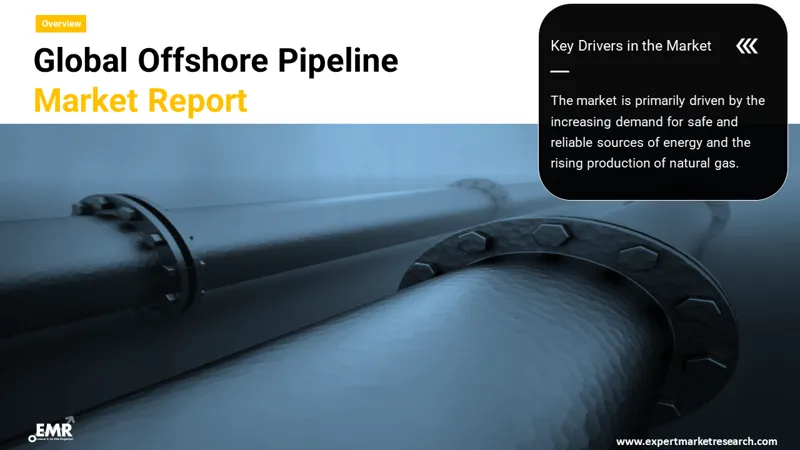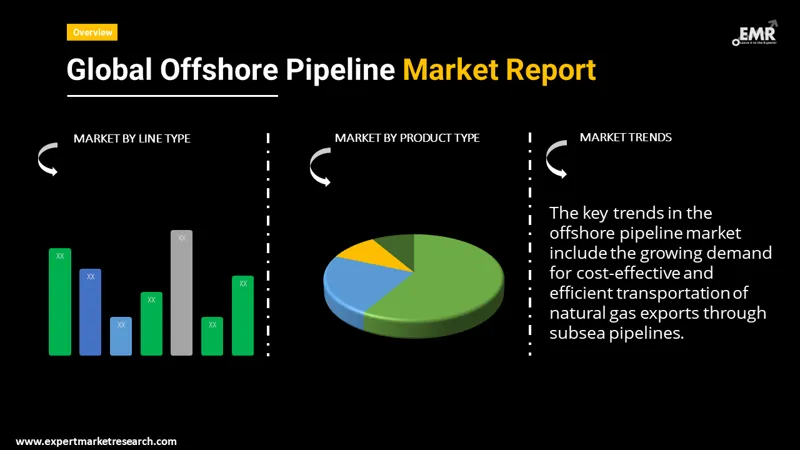
Consumer Insights
Uncover trends and behaviors shaping consumer choices today
Procurement Insights
Optimize your sourcing strategy with key market data
Industry Stats
Stay ahead with the latest trends and market analysis.
The global offshore pipeline market would likely grow at a CAGR of 5.80% during 2026-2035. Offshore pipelines are suited to transport solids (Coal, Ores, Tailings), liquids (Chemicals, Petrochemical Products, Petroleum Products, LPG, Crude Oil, and Water) and gases (natural gases and also other types of gases). Rising demand for dependable and safe sources of energy has led to an increase in offshore oil and gas production, and the establishment of pipelines to aid these operations. Asia, Pacific, North America and Europe are likely to be key markets.
Base Year
Historical Period
Forecast Period
Compound Annual Growth Rate
5.8%
2026-2035
*this image is indicative*
| Global Offshore Pipeline Market Report Summary | Description | Value |
| Base Year | USD Million | 2025 |
| Historical Period | USD Million | 2019-2025 |
| Forecast Period | USD Million | 2026-2035 |
| Market Size 2025 | USD Million | XX |
| Market Size 2035 | USD Million | XX |
| CAGR 2019-2025 | Percentage | XX% |
| CAGR 2026-2035 | Percentage | 5.80% |
| CAGR 2026-2035 - Market by Region | Asia Pacific | 6.3% |
| CAGR 2026-2035 - Market by Country | India | 6.9% |
| CAGR 2026-2035 - Market by Country | Brazil | 6.5% |
| CAGR 2026-2035 - Market by Line Type | Export Line | 6.4% |
| CAGR 2026-2035 - Market by Product Type | Oil | 6.1% |
| Market Share by Country 2025 | Japan | 4.1% |

Read more about this report - REQUEST FREE SAMPLE COPY IN PDF
Offshore pipelines are important to subsea transportation systems and enable the delivery and transportation of carbon products from resource sites to markets and end users. The construction, running and designing of offshore pipelines warrant components of risk management to alleviate probable hostile effects related to environmental, business, technical, and societal factors. The intricacy, scope, requirements and needs related to risk management have progressed with time jointly with the pipeline industry fulfilling challenges related to extending application into ice regimes and deepwater environments, and capacities to achieve more challenging operating conditions (such as temperature, internal pressure, and aggressive fluids) and envelopes (like cool down, transient, and restart conditions).
Offshore oil and gas projects comprise lengthy offshore pipelines (also called sub-sea pipelines). Offshore pipelines offer several advantages such as more safety, environmentally-friendly, less energy needs, lower maintenance costs, less impact on land-use pattern, lesser loss of product in transit, and greater reliability. Such advantages are expected to boost the global offshore pipeline market.
Through offshore pipelines, solids, liquids and gases may be transported. Generally, the products used inside offshore pipelines include liquids (Petroleum Products, Crude Oil, Chemicals, Petrochemical Products, LPG, Water), solids (in the form of slurry - coal, ores, tailings), and gas (natural gas or any other type of gas).
Sections of the offshore pipeline system include infield pipelines (pipelines under this category carry liquors within the field; infield pipelines convey a mix of oil, water, and gas from subsea wells to the process platform), export pipelines (transportation is executed from the platform to the coast of operated oil or gas; a pipeline carrying just gas or oil is called a single-phase pipeline whereas the pipeline conveying a mix of gas and oil is known as a multi-phase pipeline), and transmission pipelines (pipelines carrying gas or oil from one seashore to another).
Rising demand for dependable and safe sources of energy has led to an increase in offshore oil and gas production, and the establishment of pipelines to aid these operations. Such demand is expected to drive the global offshore pipeline market.
In 2021, it was reported that the sophisticated twin offshore pipeline Nord Stream safely conveyed 400 billion cubic metres of natural gas from Russia to Europe through the Baltic Sea since the beginning of its operation.
In 2022, McDermott International secured a Front-End Engineering Design (FEED) contract from QatarEnergy for the North Field South (NFS) Offshore Pipelines and Power/FO cables Project.

Read more about this report - REQUEST FREE SAMPLE COPY IN PDF
The EMR’s report titled “Offshore Pipeline Market Report and Forecast 2026-2035” offers a detailed analysis of the market based on the following segments:
Market Breakup by Line Type
Market Breakup by Product Type
Market Breakup by Region
| CAGR 2026-2035 - Market by | Country |
| India | 6.9% |
| Brazil | 6.5% |
| Mexico | 6.2% |
| Canada | 5.8% |
| Germany | 4.8% |
| USA | XX% |
| UK | XX% |
| France | 4.5% |
| Italy | XX% |
| China | XX% |
| Australia | XX% |
| Saudi Arabia | XX% |
| Japan | 4.0% |
The report offers an extensive assessment of major players in the global offshore pipeline market; it evaluates their capability, observes latest occurrences such as mergers and acquisitions, capacity expansions, and plant turnarounds:
Using SWOT analysis and Porter’s Five Forces model, the EMR report offers deep insights into the industry.




*While we strive to always give you current and accurate information, the numbers depicted on the website are indicative and may differ from the actual numbers in the main report. At Expert Market Research, we aim to bring you the latest insights and trends in the market. Using our analyses and forecasts, stakeholders can understand the market dynamics, navigate challenges, and capitalize on opportunities to make data-driven strategic decisions.*
Get in touch with us for a customized solution tailored to your unique requirements and save upto 35%!
The market is assessed to grow at a CAGR of 5.80% between 2026 and 2035.
The major market drivers are the growing demands for safe and dependable sources of energy and the increasing production of natural gas.
The key offshore pipeline market trends include the increasing adoption of cheap and easy transportation of natural gas exports across subsea pipelines.
The primary line types in the market for offshore pipelines include export line and transport line, among others.
The various product types in the market for offshore pipelines include oil, gas, and refined products.
The major players in the market are Saipem SpA, Enbridge Inc., Energy Transfer LP, TechnipFMC plc, McDermott International, Ltd, Sapura Energy Berhad, Atteris Pty Ltd, John Wood Group PLC, and Fugro Group, among others.
Pipelines help maintain low costs for valuable consumer goods such as natural gas, heating oil, and gasoline. Such lower prices offer a direct advantage to consumers, producers, manufacturers, and distributors throughout the supply chain.
Explore our key highlights of the report and gain a concise overview of key findings, trends, and actionable insights that will empower your strategic decisions.
| REPORT FEATURES | DETAILS |
| Base Year | 2025 |
| Historical Period | 2019-2025 |
| Forecast Period | 2026-2035 |
| Scope of the Report |
Historical and Forecast Trends, Industry Drivers and Constraints, Historical and Forecast Market Analysis by Segment:
|
| Breakup by Line Type |
|
| Breakup by Product Type |
|
| Breakup by Region |
|
| Market Dynamics |
|
| Competitive Landscape |
|
| Companies Covered |
|
Datasheet
One User
USD 2,499
USD 2,249
tax inclusive*
Single User License
One User
USD 3,999
USD 3,599
tax inclusive*
Five User License
Five User
USD 4,999
USD 4,249
tax inclusive*
Corporate License
Unlimited Users
USD 5,999
USD 5,099
tax inclusive*
*Please note that the prices mentioned below are starting prices for each bundle type. Kindly contact our team for further details.*
Flash Bundle
Small Business Bundle
Growth Bundle
Enterprise Bundle
*Please note that the prices mentioned below are starting prices for each bundle type. Kindly contact our team for further details.*
Flash Bundle
Number of Reports: 3
20%
tax inclusive*
Small Business Bundle
Number of Reports: 5
25%
tax inclusive*
Growth Bundle
Number of Reports: 8
30%
tax inclusive*
Enterprise Bundle
Number of Reports: 10
35%
tax inclusive*
How To Order

Select License Type
Choose the right license for your needs and access rights.

Click on ‘Buy Now’
Add the report to your cart with one click and proceed to register.

Select Mode of Payment
Choose a payment option for a secure checkout. You will be redirected accordingly.
Gain insights to stay ahead and seize opportunities.

Get insights & trends for a competitive edge.

Track prices with detailed trend reports.

Analyse trade data for supply chain insights.

Leverage cost reports for smart savings

Enhance supply chain with partnerships.

Connect For More Information
Our expert team of analysts will offer full support and resolve any queries regarding the report, before and after the purchase.
Our expert team of analysts will offer full support and resolve any queries regarding the report, before and after the purchase.
We employ meticulous research methods, blending advanced analytics and expert insights to deliver accurate, actionable industry intelligence, staying ahead of competitors.
Our skilled analysts offer unparalleled competitive advantage with detailed insights on current and emerging markets, ensuring your strategic edge.
We offer an in-depth yet simplified presentation of industry insights and analysis to meet your specific requirements effectively.
Share